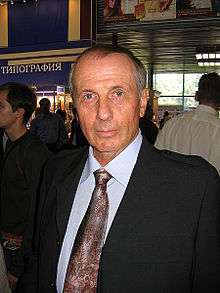Kamianets-Podilskyi
Kamianets-Podilskyi (Ukrainian: Ка́м'яне́ць-Поді́льський, Polish: Kamieniec Podolski, Romanian: Camenița, Russian: Каменец-Подольский, Yiddish: קאמענעץ־פאדאלסק) is a city on the Smotrych River in western Ukraine, to the north-east of Chernivtsi. Formerly the administrative center of the Khmelnytskyi Oblast, the city is now the administrative center of the Kamianets-Podilskyi Raion (district) within the Khmelnytskyi Oblast (province). The city itself is also designated as a separate district within the region.
Kamianets-Podilskyi Кам'янець-Подільський Kamieniec Podolski | |
|---|---|
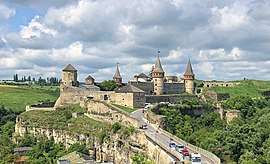  .jpg)    | |
 Flag  Coat of arms | |
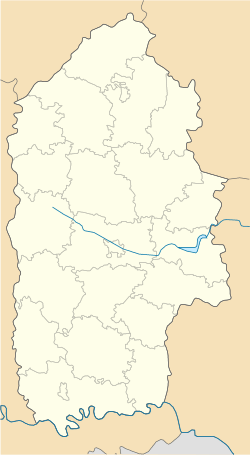 Kamianets-Podilskyi Location in Ukraine  Kamianets-Podilskyi Kamianets-Podilskyi (Ukraine) | |
| Coordinates: 48°41′00″N 26°35′00″E | |
| Country | |
| Oblast | |
| Raion | Kamianets-Podilskyi Raion |
| Founded | 1062 (first mentioned) |
| City rights | 1432 |
| Government | |
| • Mayor | Mikhaylo Simashkevich |
| Area | |
| • Total | 27,871 km2 (10,761 sq mi) |
| Population (2019) | |
| • Total | 99 046[1] |
| Time zone | UTC+2 (EET) |
| • Summer (DST) | UTC+3 (EEST) |
| Postal code | 32300—32318 |
| Area code(s) | +380-3849 |
| Sister cities | Targówek, Kraków, Głogów, Przemyśl, Kalisz, Sanok, Gniew, Zawiercie, Ejmiatsin, Suzhou, Ukmergė, Polatsk, Edineţ, Zalău, Dolný Kubín, Ponte Lambro, Michurinsk |
In 1919–1920 during the ongoing Ukrainian–Soviet War, the city had officially served as a temporary capital of Ukrainian People's Republic.[2]
Name
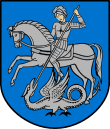
The first part of the city's dual name originates from kamin' (Ukrainian: камiнь) or kamen, meaning "stone" in Old Slavic. The second part of its name relates to the historic region of Podolia (Ukrainian: Подíлля) of which Kamianets-Podilskyi is considered to be the historic capital.
Equivalents of the name in other languages are Polish: Kamieniec Podolski; Romanian: Camenița Podoliei; Turkish: Kamaniçe; Latin: Camenecium; Hungarian: Kamenyeck-Podolszk; Yiddish: קאָמענעץ (Komenets)
Geography
Kamianets-Podilskyi is located in the southern portion of the Khmelnytskyi Oblast, located in the western Ukrainian region of Podillia. The Smotrych River, a tributary of the Dniester, flows through the city. The total area of the city comprises 27.84 square kilometers (10.7 sq mi).[3] The city is located about 101 kilometres (62.8 mi) from the oblast's administrative center, Khmelnytskyi.[3]
History
Several historians consider that a city on this spot was founded by the ancient Dacians, who lived in what is now modern Romania, Moldova, and portions of Ukraine.[4] Historians write that the founders named the settlement Petridava or Klepidava, which originate from the Greek word petra or the Latin lapis meaning "stone" and the Dacian dava meaning "city".[4][5]
Middle ages
Modern Kamianets-Podilskyi was first mentioned in 1062 as a town of the Kievan Rus' state. In 1241, it was destroyed by the Mongolian invaders.[6] In 1352, it was annexed by the Polish King Casimir III. In 1378 it became seat of a Roman Catholic Diocese. In 1432 King Sigismund I the Old granted Kamieniec Podolski city rights. In 1434 it became the capital of the Podolian Voivodship and the seat of local civil and military administration.[6] The ancient castle was reconstructed and substantially expanded by the Polish kings to defend Poland from the southwest against Ottoman and Tatar invasions, thus it was called the gateway to Poland.
Modern times
During the free election period in Poland, Kamianets-Podilskyi, as one of the most influential cities of the state, enjoyed voting rights (alongside Warsaw, Kraków, Poznań, Gdańsk, Lwów, Wilno, Lublin, Toruń and Elbląg).
After the Treaty of Buchach of 1672, Kamianets-Podilskyi was briefly part of the Ottoman Empire and capital of Podolya eyalet. To counter the Turkish threat to the Polish-Lithuanian Commonwealth, King Jan III Sobieski built a fortress nearby, Okopy Świętej Trójcy (now Okopy, Ternopil Oblast; meaning "the Entrenchments of the Holy Trinity"). In 1687, Poland attempted to regain control over Kamianets-Podilskyi and Podolia, when the fortress was unsuccessfully besieged by the Poles led by Prince James Louis Sobieski. In 1699, the city was given back to Poland under King Augustus II the Strong according to the Treaty of Karlowitz. The fortress was continually enlarged and was regarded as the strongest in the Polish-Lithuanian Commonwealth. The preserved ruins of the fortress still contain the iron cannonballs stuck in them from various sieges.
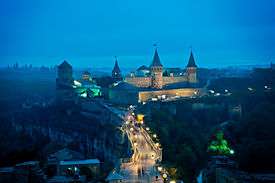
After the Second Partition of Poland in 1793, the city belonged to the Russian Empire, where it was the capital of the Podolia Governorate. The Russian Tsar Peter the Great, who visited the fortress twice, was impressed by its fortifications. One of the towers was used as a prison cell for Ustym Karmeliuk, a prominent peasant rebel leader of the early 19th century), who managed to escape from it three times. In 1798, Polish nobleman Antoni Żmijewski founded a Polish theatre in the city. It was one of the oldest Polish theatres. In 1867 the Roman Catholic Diocese of Kamyanets-Podilskyi was abolished by the Russians authorities. It was re-established in 1918 by Pope Benedict XV.
According to the Russian census of 1897, Kamianets-Podilskyi remained the largest city of Podolia with a population of 35,934. In 1914, a direct railway line linked the city to Proskurov.
World War I
During World War I, the city was occupied by Austria-Hungary in 1915. With the collapse of the Russian Empire in 1917, the city was briefly incorporated into several short-lived Ukrainian states: the Ukrainian People's Republic, the Hetmanate, and the Directoriya, before ending up as part of the Ukrainian SSR when Ukraine fell under Bolshevik power. During the Directorate period, the city was chosen as de facto capital of Ukraine after the Russian Communist forces occupied Kiev. During the Polish-Soviet War, the city was captured by the Polish Army and was under Polish administration from 16 November 1919, to 12 July 1920. It was later ceded to Soviet Russia in the 1921 Treaty of Riga, which determined the future of the area for the next seven decades as part of the Ukrainian SSR.
Soviet times
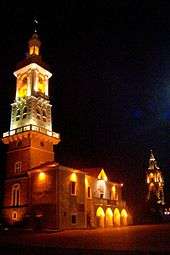
Poles and Ukrainians have always dominated the city's population. However, as a commercial center, Kamianets-Podilskyi has been a multiethnic and multi-religious city with substantial Jewish and Armenian minorities. Under Soviet rule it became subject to severe persecutions, and many Poles were forcibly deported to Central Asia. Massacres such as the Vinnytsia massacre have taken place throughout the Podillya, the last resort of the independent Ukraine. Early on, Kamianets-Podilskyi was the administrative center of the Ukrainian SSR's Kamianets-Podilskyi Oblast, but the administrative center was later moved to Proskuriv (now Khmelnytskyi).
In December 1927, TIME Magazine reported that there were massive uprisings of peasants and factory workers in southern Ukraine, around the cities of Mohyliv-Podilskyi, Kamianets-Podilskyi, Tiraspol and others, against Soviet authorities. The magazine was intrigued when it found numerous reports from the neighboring Romania that troops from Moscow were sent to the region and suppressed the unrest, causing no less than 4,000 deaths. The magazine sent several of its reporters to confirm those occurrences which were completely denied by the official press naming them as barefaced lies.[7] The revolt was caused by the collectivization campaign and the lawless environment in the cities caused by the oppressive Soviet government.
Following the Soviet invasion of Poland, the administrative center of the oblast was moved from the city of Kamianets-Podilskyi to the city of Khmelnytskyi. Kamianets-Podilskyi was occupied by the German troops on 11 July 1941 in the course of Operation Barbarossa.[8] On 27 March 1944 the town was freed in the battle from the Kamenets-Podolsky pocket from the German occupation by the Red Army. Kamianets remained in the Soviet Ukraine until the Dissolution of the Soviet Union. On 16 January 1991, Pope John Paul II re-established the Roman Catholic Diocese of Kamyanets-Podilskyi, which was dissolved under the Soviet rule.
As of 2015, Kamianets-Podilskyi is the third-largest city of Podolia after Vinnytsia and Khmelnytskyi.
Jewish history
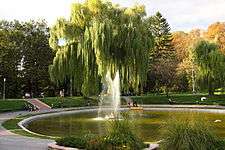
During the Khmelnytsky Uprising (1648–58), the Jewish community of Kamianets-Podilskyi suffered much from Khmelnytsky's Cossacks on the one hand, and from the attacks of the Crimean Tatars (their main object being the extortion of ransoms) on the other.[9]
About the middle of the 18th century, Kamianets-Podilskyi became celebrated as the center of the furious conflict then raging between the Talmudic Jews and the Frankists. The city was the residence of Bishop Dembowski, who sided with the Frankists and ordered the public burning of the Talmud, a sentence which was carried into effect in the public streets in 1757.[9]
Kamianets-Podilskyi was also the residence of the wealthy Joseph Yozel Günzburg. During the latter half of the 19th century, many Jews from Kamianets-Podilskyi emigrated to the United States, especially to New York City, where they organized a number of societies.[9]
One of the first and largest Holocaust massacres carried out in the opening stages of war between Nazi Germany and the Soviet Union, took place in Kamianets-Podilskyi on 27–28 August 1941. The killings were conducted by the Police Battalion 320 of the Order Police along with Friedrich Jeckeln's Einsatzgruppen, the Hungarian soldiers, and the Ukrainian Auxiliary Police.[10][11] According to Nazi German reports, in two days a total of 23,600 Jews from the Kamianets-Podilskyi Ghetto were murdered, including 16,000 expellees from Hungary.[12] As the historians of the Holocaust point out, the massacre constituted a prelude to the Final Solution conceived by the Nazis at Wannsee several months later. Eyewitnesses reported that the perpetrators made no effort to hide their deeds from the local population.[13]
Culture
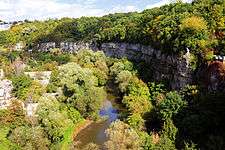
Main sights
The different peoples and cultures that have lived in the city have each brought their own culture and architecture. Examples include the Polish, Ruthenian and Armenian markets.[6] Famous tourist attractions include the ancient castle, and the numerous architectural attractions in the city's center, including the cathedral of Saints Peter and Paul, Holy Trinity Church, the city hall building, and the numerous fortifications.
Ballooning activities in the canyon of the Smotrych River have also brought tourists. Since the late 1990s, the city has grown into one of the chief tourist centers of western Ukraine. Annual Cossack Games (Kozatski zabavy) and festivals, which include the open ballooning championship of Ukraine, car racing and various music, art and drama activities, attract an estimated 140,000 tourists and stimulate the local economy. More than a dozen privately owned hotels have recently opened, a large number for a provincial Ukrainian city.
International relations
Notable individuals
- Mikhail Alperin (born 1956), Ukrainian jazz pianist
- Andrei Bondarenko (born 1987), Ukrainian operatic baritone, born here
- Nikolai Chebotaryov (1894–1947), Russian and Soviet mathematician, best known for the Chebotaryov density theorem.
- Moisey Gamarnik (born 1936), Soviet and Ukrainian physicist and inventor, born here.
- Sergey Gorshkov (1910-1988), Russian and Soviet Admiral of the fleet of the Soviet Union, born here.
- David Günzburg (Baron de Günzburg; 1857–1910) Russian orientalist and Jewish communal leader, born here.
- Józef Kallenbach (1861–1929), Polish historian of literature, born here.
- Yuriy Khimich (1928–2003), Ukrainian painter, born here
- Andrii Klantsa (born 1980), cardiac surgeon, scientist, Merited Doctor of Ukraine, Doctor of Science in Public Administration.
- Stanisław Koniecpolski (1590 or 1594–1646), Polish military commander, fought here.
- Mark Kopytman (1929–2011), Soviet-Israeli composer, musicologist, and pedagogue, born here
- Murray Korman (1902–1961), American publicity photographer
- Leib Kvitko (1890–1952), Yiddish poet, author of children's poems, and member of the Jewish Anti-Fascist Committee
- Mykola Leontovych (1877–1921), Ukrainian composer, studied and graduated from the city's Theological Seminary
- Iryna Merleni (born 1982), female wrestler.
- Aleksander Michałowski (1851–1938), Polish pianist, born here.
- Mieczysław Mickiewicz (1879–before 1939), Polish politician, born here.
- Szymon Okolski (1580–1653), Polish historian; lived here.
- Ferdynand Antoni Ossendowski (1876—1945), Polish writer, explorer, professor, anti-communist and political activist; lived here.
- José Antonio Saravia (1785–1871), Spanish-born Russian general during the Napoleonic Wars; married and lived here.
- Joseph Saunders (engraver) (1773-1854), English printmaker lived and died here
- Morris Schappes (1907–2004), American educator, writer, radical political activist, historian, and magazine editor
- Zvee Scooler (1899–1985), actor and radio commentator, best known as the Rabbi in Fiddler on the Roof; born here.
- Mendele Mocher Sforim (1836–1917), Jewish author; lived here
- Leo Sirota (1885-1965), Jewish pianist
- Samuel Spielberg, Steven Spielberg's paternal grandfather.
- Mihail Starenki (1879–?), Bessarabian politician; born here.
- Leonid Stein (1934–1973), Soviet chess Grandmaster; born here.
- Moshe Stekelis (1898–1967), Russian-Israeli archaeologist
- Arthur Tracy (1899–1997), American singer; born here.
- Anton Vasyutinsky (1858–1935), painter, coin and medal designer; born here.
- Mikhail Veller (born 1948), Russian-Estonian writer; born here.
- Ion Vinokur (1930–2006), Ukrainian archaeologist, historian; lived and worked here.
- Jan de Witte (1709–1785), Polish architect and commander of the local fortress.
- Jerzy Wołodyjowski, Polish colonel, prototype for one of Henryk Sienkiewicz's characters, Michał Wołodyjowski; killed here.
- Józef Zajączek (1752–1826), Polish general, born here.
- Maurice Zbriger (1896–1981), Canadian violinist, composer, and conductor; born here.
- Isidor Zuckermann (1866–1946), Austrian businessman
Gallery
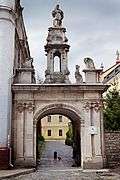 Arch of triumph
Arch of triumph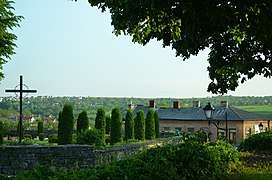 Church backyard near the castle
Church backyard near the castle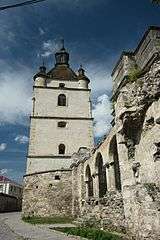 Armenian Bell Tower
Armenian Bell Tower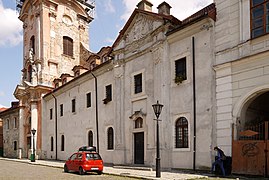 Dominican monastery
Dominican monastery.jpg) Alexander Nevsky Cathedral
Alexander Nevsky Cathedral- Virmensky rynok
- Kamianets-Podilskyi district administration
 College of arts
College of arts- Consistorium building
- Zarvanska Street
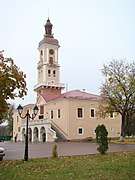 Polish magistrate building
Polish magistrate building- Starobul'varna Street
- Former seminary building
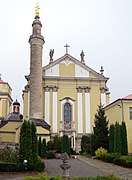 St. Peter and Paul Cathedral
St. Peter and Paul Cathedral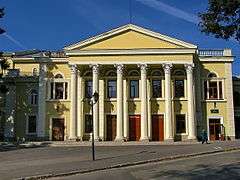 Pushkin People's House
Pushkin People's House- Court building
 Gymnasium on Shevchenko Street
Gymnasium on Shevchenko Street
References
- Notes
- Чисельність населення (за оцінкою) на 1 грудня 2019 року // Головне управління статистики у Хмельницькій області
- Pustynnikov, Iryna. The last capital of Ukrainian People's Republic (Остання столиця УНР). Newspaper "Den". 14 October 2011
- "Geography". kp.rel.com.ua (in Ukrainian). Archived from the original on 28 September 2007. Retrieved 25 October 2007.
- "The Museum City". Kamianets-Podilskyi. Art/Ukrainian. Archived from the original on 12 October 2007. Retrieved 26 October 2007.
- "Perła Podola". niedziela.pl (in Polish). Archived from the original on 22 May 2011. Retrieved 26 October 2007.
- "History". kp.rel.com.ua (in Ukrainian). Archived from the original on 28 September 2007. Retrieved 25 October 2007.
- Disorder in the Ukraine?, TIME Magazine, 12 December 1927
- Davis, Martin, ed. (2010). "The Nazi Invasion of Kamenets". JewishGen.
- "Kamenetz-Podolsk:". JewishEncyclopedia.com. Retrieved 8 July 2009.
- Timothy Snyder (2010). Bloodlands: Europe Between Hitler and Stalin. Basic Books. pp. 200–204. ISBN 0465002390.
- Martin Davis. "Kamyanets-Podilskyy" (PDF). pp. 11-14 / 24 in PDF – via direct download. Cite journal requires
|journal=(help) Also in: Martin Davis (2010). "The Nazi Invasion of Kamenets". JewishGen. - Randolph L. Braham (2000). The Politics of Genocide. Wayne State University Press. p. 34. ISBN 0814326919.
- Gross, S.Y.; Cohen, Yosef, eds. (1983). "Chapter 7 - The Holocaust of Jewish Marmaros". The Marmaros Book - In Memory of 160 Jewish Communities. Tel Aviv: Beit Marmaros.
- "Kalisz Official Website – Twin Towns" (in Polish). Archived from the original on 25 September 2011. Retrieved 29 November 2008.
- Bibliography
- Olha Plamenytska, ed. (2003). Tourist guide Kamianets-Podilskyi (in Ukrainian). Lviv: Tsentr Yevropy. ISBN 966-7022-46-3. Archived from the original on 16 November 2007.
External links
- "Virtual travel 3D in Kamianets-Podilskyi". www.karta3d.com (in Russian). Archived from the original on 4 June 2012. Retrieved 26 October 2013.
- "Kamianets-Podilskyi information site". kam-pod.info. Retrieved 26 October 2013.
- "City's official website". kam-pod.gov.ua (in Ukrainian). Retrieved 12 March 2012.
- "Informational portal". www.kp-tour.com.ua (in Russian). Archived from the original on 24 October 2007. Retrieved 25 October 2007.
- "Kamianets". castles.com.ua (in Ukrainian). Retrieved 18 October 2007.
- "The old fortress on the Smotrich River," in Zerkalo Nedeli (Mirror Weekly), 28 June – 5 July 2002, available online in Ukrainian and in Russian
- "Kamenets-Podolskiy Flower on the Rock". Vokrug Sveta (in Russian). Retrieved 25 October 2007.
- History of Jewish Community in Kamenets-Podolski
- The murder of the Jews of Kamianets-Podilskyi during World War II, at Yad Vashem website.
- The Lost Jewish Community of Kamenets-Podolsk
- Execution of Jews in Kamyanets-Podilskyi
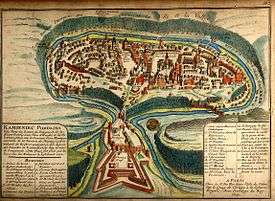
.jpg)


